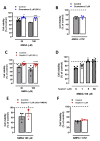Sephin1 Protects Neurons against Excitotoxicity Independently of the Integrated Stress Response
- PMID: 32846985
- PMCID: PMC7504470
- DOI: 10.3390/ijms21176088
Sephin1 Protects Neurons against Excitotoxicity Independently of the Integrated Stress Response
Abstract
Sephin1 is a derivative of guanabenz that inhibits the dephosphorylation of the eukaryotic initiation factor 2 alpha (eIF2α) and therefore may enhance the integrated stress response (ISR), an adaptive mechanism against different cellular stresses, such as accumulation of misfolded proteins. Unlike guanabenz, Sephin1 provides neuroprotection without adverse effects on the α2-adrenergic system and therefore it is considered a promising pharmacological therapeutic tool. Here, we have studied the effects of Sephin1 on N-methyl-D-aspartic acid (NMDA) receptor signaling which may modulate the ISR and contribute to excitotoxic neuronal loss in several neurodegenerative conditions. Time-course analysis of peIF2α levels after NMDA receptor overactivation showed a delayed dephosphorylation that occurred in the absence of activating transcription factor 4 (ATF4) and therefore independently of the ISR, in contrast to that observed during endoplasmic reticulum (ER) stress induced by tunicamycin and thapsigargin. Similar to guanabenz, Sephin1 completely blocked NMDA-induced neuronal death and was ineffective against AMPA-induced excitotoxicity, whereas it did not protect from experimental ER stress. Interestingly, both guanabenz and Sephin1 partially but significantly reduced NMDA-induced cytosolic Ca2+ increase, leading to a complete inhibition of subsequent calpain activation. We conclude that Sephin1 and guanabenz share common strong anti-excitotoxic properties with therapeutic potential unrelated to the ISR.
Keywords: NMDA; Sephin1; calcium; calpain; excitotoxicity; guanabenz; integrated stress response.
Conflict of interest statement
The authors declare no conflict of interest.
Figures





Similar articles
-
Alpha-lipoic acid protects against cadmium-induced neuronal injury by inhibiting the endoplasmic reticulum stress eIF2α-ATF4 pathway in rat cortical neurons in vitro and in vivo.Toxicology. 2019 Feb 15;414:1-13. doi: 10.1016/j.tox.2018.12.005. Epub 2018 Dec 31. Toxicology. 2019. PMID: 30605698
-
Guanabenz ameliorates disease in vanishing white matter mice in contrast to sephin1.Ann Clin Transl Neurol. 2022 Aug;9(8):1147-1162. doi: 10.1002/acn3.51611. Epub 2022 Jul 1. Ann Clin Transl Neurol. 2022. PMID: 35778832 Free PMC article.
-
Sephin1 Reduces Prion Infection in Prion-Infected Cells and Animal Model.Mol Neurobiol. 2020 May;57(5):2206-2219. doi: 10.1007/s12035-020-01880-y. Epub 2020 Jan 24. Mol Neurobiol. 2020. PMID: 31981074
-
Sephin1, which prolongs the integrated stress response, is a promising therapeutic for multiple sclerosis.Brain. 2019 Feb 1;142(2):344-361. doi: 10.1093/brain/awy322. Brain. 2019. PMID: 30657878 Free PMC article.
-
PPP1R15A-mediated dephosphorylation of eIF2α is unaffected by Sephin1 or Guanabenz.Elife. 2017 Apr 27;6:e26109. doi: 10.7554/eLife.26109. Elife. 2017. PMID: 28447936 Free PMC article.
Cited by
-
Protein Misfolding and Aggregation as a Mechanistic Link Between Chronic Pain and Neurodegenerative Diseases.Curr Issues Mol Biol. 2025 Apr 8;47(4):259. doi: 10.3390/cimb47040259. Curr Issues Mol Biol. 2025. PMID: 40699658 Free PMC article. Review.
-
PERK modulation, with GSK2606414, Sephin1 or salubrinal, failed to produce therapeutic benefits in the SOD1G93A mouse model of ALS.PLoS One. 2024 Feb 15;19(2):e0292190. doi: 10.1371/journal.pone.0292190. eCollection 2024. PLoS One. 2024. PMID: 38359044 Free PMC article.
-
Secondary Mechanisms of Neurotrauma: A Closer Look at the Evidence.Diseases. 2022 May 23;10(2):30. doi: 10.3390/diseases10020030. Diseases. 2022. PMID: 35645251 Free PMC article. Review.
-
Sephin1 suppresses ER stress-induced cell death by inhibiting the formation of PP2A holoenzyme.Cell Death Dis. 2025 Feb 19;16(1):117. doi: 10.1038/s41419-025-07450-1. Cell Death Dis. 2025. PMID: 39971896 Free PMC article.
-
Cell Signaling in Neurodegeneration.Int J Mol Sci. 2021 Aug 20;22(16):8978. doi: 10.3390/ijms22168978. Int J Mol Sci. 2021. PMID: 34445683 Free PMC article.
References
MeSH terms
Substances
Grants and funding
LinkOut - more resources
Full Text Sources
Other Literature Sources
Miscellaneous

